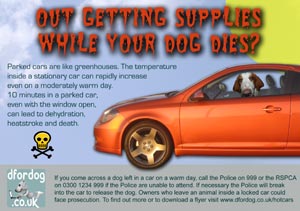Parked Cars Cook Dogs
Each summer we like to remind people of our campaign to raise awareness of the dangers of leaving dogs in parked cars on warm days. If you find the information below informative and even shocking, you can help us spread the word by telling other dog owners how lethal parked cars can be to dogs left inside them. You can also help us spread the word by printing off and handing out one of our flyers, which are of course free to download.

Many dogs die every year after their owners leave them in parked cars for long or short periods of time, thinking their dog is safe but not realising the dangers animals face in this situation. Leaving your dog in a parked car even for a short period of time can prove fatal.
The temperature inside the car might not seem excessive when you first stop but the temperature inside a stationary car can rapidly increase to double the outside temperature. This can happen very quickly, within six to ten minutes.
The inside of a parked car will soon become far hotter than the outside temperature simply because a car traps the heat from the sun just like a greenhouse. This is why warm temperatures outside can quickly become deadly temperatures inside a stationary car. Even on comparatively cool days a car's internal temperature can rocket and keeping the windows open a crack hardly slows the rise at all.
Add to this the fact that your dog has on a fur coat that is designed to trap heat, and you can really begin to see why leaving dogs in parked cars can be so fatal. Also, they cannot sweat to cool down and have to rely on panting to regulate their body temperature.
The advice can only be this - never leave your dog in a parked car on a warm day, even for a few minutes. Leaving the window open a few inches, parking in the shade, or even leaving the dog a bowl of water is NOT adequate. A dog left in a car on a hot or even warm day can suffer heat stress and ultimately fatal heat stroke within just 10 minutes.
If you come across a dog that has been left in a car on a warm day, call the Police on 999 for assistance. They will be able to take appropriate action, if necessary breaking into the car to release the dog. If the Police are unable to attend, call the RSPCA on 0300 1234 999. It is also worth noting that owners who put an animal at risk by leaving it inside a locked car could face prosecution.
Help us in our campaign
If you have found the information in this article informative and even shocking, you can help us spread the word by telling other dog owners how lethal parked cars can be to dogs left inside them. You can also help us spread the word by printing off and handing out one of our flyers, which are of course free to download.
Using these flyers we hope to target places where dogs are often left in cars, such as the supermarket car park, outside other shops and stores, petrol stations, and even work places. These flyers would also be perfect for putting on notice boards in shops, veterinary practices, dog clubs, pet shops, at the work place and any other places you think dog owners might look. Even popping one in the window of your car could reach a good audience and might save a dog’s life.
Download full colour flyer (277kB pdf)
Download plain colour flyer (294kB pdf)
Dehydration
One sign of dehydration is loss of skin elasticity. If you think your dog might be dehydrated, do this simple check. When the skin along the back is picked up into a fold, it should spring back into place. In dehydration, the skin stays up in a ridge. Another sign is dryness of the mouth. Late signs of dehydration are sunken eyes and circulatory collapse.
If your dog is dehydrated or very thirsty, do not let them gulp down excessive amounts of water at once as they are likely to bring it back up. Give your dog an electrolyte mixed in water, which will be more effective than plain water at replenishing the body. To hydrate slowly, give your dog ice to lick rather than letting them take large gulps of water.
Heatstroke
Heatstroke can kill an animal very quickly. The signs of heatstroke are:
1) At first the dog will pant more than usual, become agitated and may sound uncomfortable or distressed.
2) Panting will become excessive and difficult and drooling may also start.
3) The dog will struggle to breathe and may appear glassy eyed and have dark red gums.
4) Body temperature has risen to a point where cell death in the brain results in seizures, coma and ultimately death. In these later stages, even with intensive veterinary care, your pet will probably die.
To help a dog with heatstroke, you need to cool the dog down. Put the dog in the coolest place you can find. Gently apply cool (not freezing cold) wet towels or water to the head, neck and chest. This will lower the dog’s temperature gradually without causing shock to the system. When the dog seems stable, take it straight to a veterinary surgery for professional medical care.
By Jenny Prevel
© D for Dog www.dfordog.co.uk
This article belongs strictly to D for Dog and we do not authorise the copying of all or any part of it.
